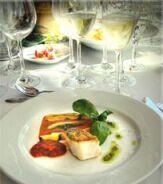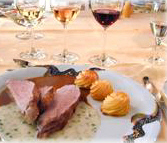| Introduction
| How Wine is made I
| How Wine is made II
| How Wine is made III |
| Climate and Quality
| Serving and Testing
| Wine and Food
|
IV. Matching German Wines with Food
Some Basic Guidelines
 German wines are the world's most versatile wines.
They match excellently with most foods, equally at home with the finest culinary creations and with simple,
everyday foods. Because they are lower in alcohol, crisp and fruity, German wines are excellent sipping wines,
while one is relaxing with friends, music or a good book.
German wines are the world's most versatile wines.
They match excellently with most foods, equally at home with the finest culinary creations and with simple,
everyday foods. Because they are lower in alcohol, crisp and fruity, German wines are excellent sipping wines,
while one is relaxing with friends, music or a good book.
 And the famous Auslese wines, rich, luxurious and sweet, are incomparable as dessert wines, served before or with dessert.
But that is only the beginning! Because they are naturally light and refreshing, German wines as a whole are often recommended
and served as apéritif wines, tantalizing the palate with the crispness of fruit without overpowering.
And the famous Auslese wines, rich, luxurious and sweet, are incomparable as dessert wines, served before or with dessert.
But that is only the beginning! Because they are naturally light and refreshing, German wines as a whole are often recommended
and served as apéritif wines, tantalizing the palate with the crispness of fruit without overpowering.
 Due to the range of available types, German wines are exceptionally satisfying with a wide
array of foods and are appropriate throughout the meal. Indeed, one can safely say that there is an appropriate German wine
for almost every dish and every occasion.
Due to the range of available types, German wines are exceptionally satisfying with a wide
array of foods and are appropriate throughout the meal. Indeed, one can safely say that there is an appropriate German wine
for almost every dish and every occasion.
In making a suitable selection to accompany a particular dish or meal,
the two primary factors to consider are:
1. the ripeness or quality category and taste of the particular German wine
2. the flavour intensity of the dish, including sauces, spices and condiments.
|
Wines function in two ways to add excitement to the taste of food: 1) complimentarily flavours in the wines may enhance similar flavours in the food; or 2) conversely, a fruity refreshing taste in the wine may counterbalance noticeable spiciness in the food. This is one reason that German wines are such superb matches with spicy Oriental and international dishes. |

Because of their high natural acidity and crispness, German wines cut through fats,
proteins and strong food flavours, and serve to refresh and cleanse the palate. At the same time,
a German wine's fruit intensity can stand up to the food's own flavour.
If the food has a very strong taste, an intensely flavoured German wine will be called for to balance the food.
Alternatively, if the food is delicate in flavour, a milder and more subtle German wine might be in order.
Wine crystals - A sign of quality
Many of Germany's white wines are treated to cold stabilization before being bottled.
This is the process of storing wine in below freezing temperatures in order to eliminate the tartaric crystals (Weinsteine)
that tend to form in finer wines, especially in good harvests.
These tiny crystals which you may find on the cork or at the bottom of a bottle are not flaws, they are harmless,
tasteless and in no way detract from the flavour of the wine. On the contrary, they are considered a sign of quality.